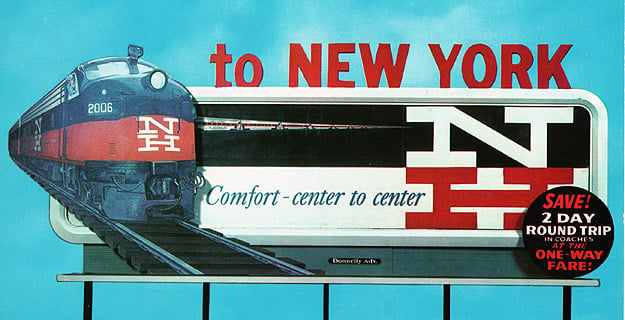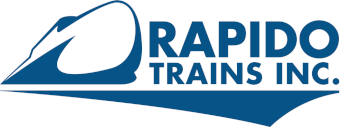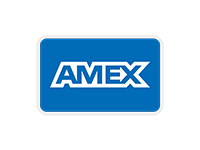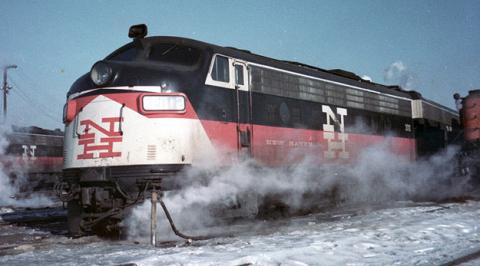
NHRHTA Collection
The Unique FL9
The FL9 included many unusual design features. While based on the standard EMD F-series locomotives, the FL9 was eight feet longer than a stndard F-unit (and four feet longer than an FP9A) in order to handle a larger steam heater boiler and other extra equipment. To support the rear of the unit and to more evenly distribute the extra weight EMD used an A-1-A version (center axle unpowered) of its three-axle Flexicoil truck, normally seen with all axles powered under SD type locomotives. The front trucks were two-axle units. The initial two locomotives, #2000 and 2001, were built with standard Blomberg sideframes. These were quickly replaced by a 9’ wheelbase version of EMD’s Flexicoil B-truck. All other FL9 locomotives were built with Flexicoils. Retractable outside third rail pickup shoes were fitted to both sides on both the front and rear trucks. These were designed to operate on the New York Central’s outside third rail into Grand Central. All units were equipped with melodic Hancock air whistles as built.

NHRHTA Collection
New Haven Detail Variations
The FL9 was built in two batches of thirty units each. The first group, built between October 1956 and November 1957, included road numbers 2000-2029 and were classified EDER-5 (Electric Diesel-Electric Road) on the New Haven. The second group, road numbers 2030-2059 class were classified EDER-5a and were built in 1960. Unit #2059 was the last F-unit ever built by EMD.
There were subtle differences between the two construction groups. The first group, road numbers 2000-2029, featured nose MU doors and hoses and a small pantograph on the roof for use inside Grand Central Terminal. The second group, road numbers 2030-2059, did not have the nose MU equipment nor the pantograph, it having proved to be a failed experiment. The second group were also fitted as-built with side platforms on both sides of the nose along with additional grab irons both on the nose and L-shaped grabs above each cab windshield.

NHRHTA Collection

NHRHTA Collection
The New Haven, ever thrifty and resourceful (cheap?), removed the platforms and the grabs from the left side of each of the second group of EDER-5a units and applied them to the right side of the earlier batch that were already in service! The railroad also added an L-shaped grab above the right side windshield on the earlier units, but only a half-length grab above the left side windshield. These mis-matched grabs stayed on these units throughout their service life.
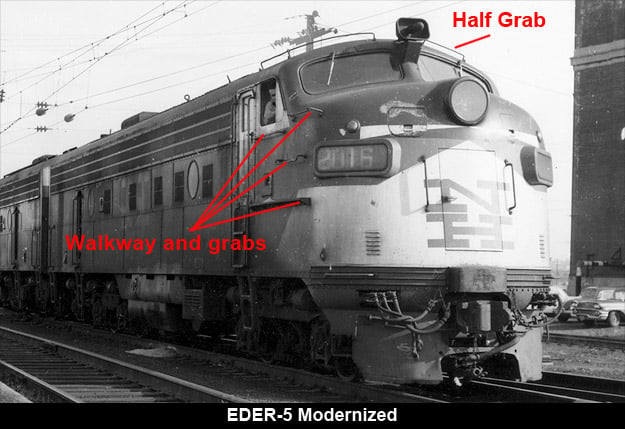
NHRHTA Collection
Life After the New Haven
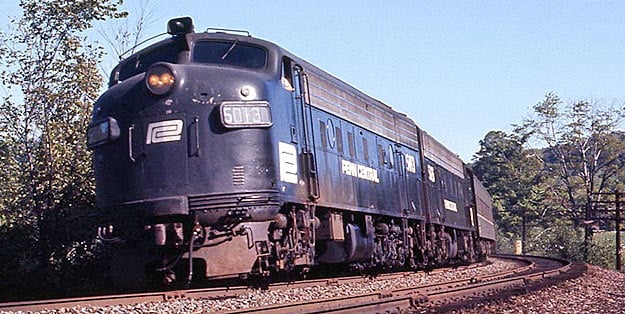
Collection Otto M. Vondrak
Penn Central
In 1969, New Haven was included in the 11-month old Penn Central merger. The FL9s continued to soldier on for PC, being renumbered into the 5000 series. At that time, Penn Central management was still confident of a successful future, and quickly painted many FL9s into variations of its black scheme. Early repaints included the PC "mating worm" logs, while later versions received just dip black. Penn Central also repainted many NH Osgood-Bradley coaches in its green passenger scheme at the same time. The majority of the FL9 fleet continued to work in untouched New Haven colors with just the new 5000-series numbers indicated the units' new owner. In the early Seventies, many of these engines finally had PC logos applied over painted-out NH emblems.
During this time the side skirts above the fuel tanks started being removed as well.
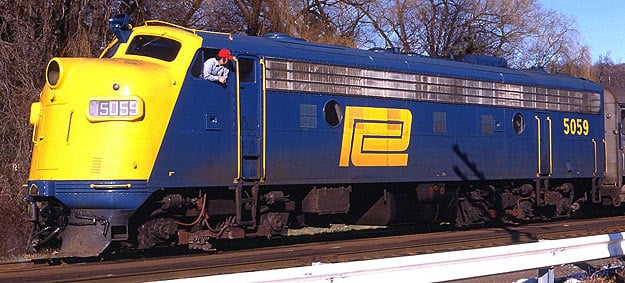
Photo by Art Deeks, Collection Otto M. Vondrak
In the early 1970s the Metropolitan Transportation Authority of New York (MTA) took over responsibility for Penn Central’s commuter operations. During this time some color reappeared with many of the FL9s being repainted in New York State’s colors of blue and yellow. Typical perhaps of PC's practices at the time there were several variations in color arrangements and lettering, with some units having full yellow roofs, some with partial yellow nose and others with blue roofs!
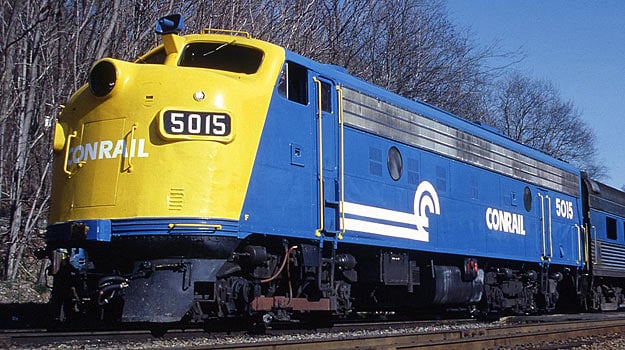
Photo by Art Deeks, Collection Otto M. Vondrak
Conrail and Commuter Authorities
With the formation of Conrail on April 1, 1976 the FL9 would wear yet another blue and yellow scheme but this time in Conrail blue with a yellow nose and white lettering. Again, there were variations, with some units having Conrail's "Can Opener" logo on the sides while others did not.
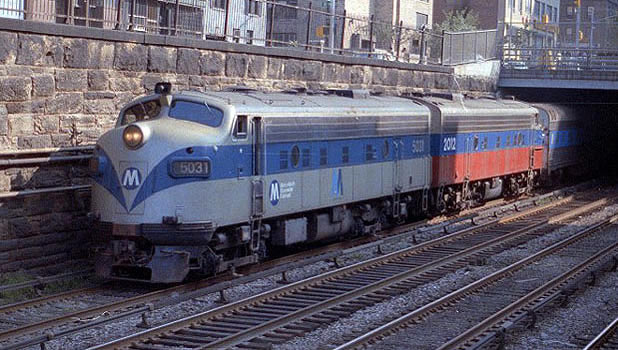
Metro North FL9. Craig Zeni photo
In 1979, MTA funded the rebuilding of seven Conrail FL9s by General Electric at Hornell, New York. These units returned in a scheme that was unique to the seven: silver with a broad blue stripe.
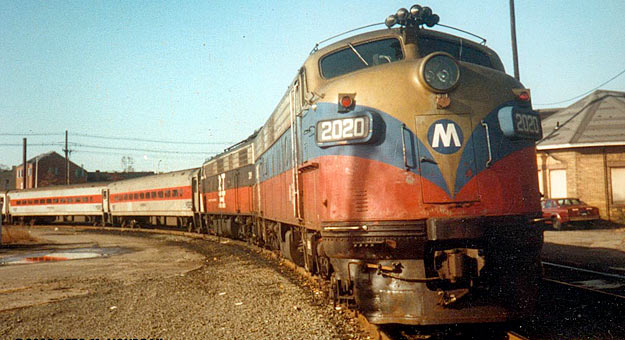
MTA FL9. Photo by Otto M. Vondrak
In 1983, the Metro-North Commuter Railroad, a subsidiary of MTA, was created. MNCR acquired 33 Conrail FL9s, not all serviceable. Eventually, 28 were repainted in a modified version of the earlier MTA scheme, with red replacing the silver on the lower portion of the locomotive.
Amtrak
Amtrak acquired a total of twelve FL9s in two groups in 1975 and 1976. These units were quickly rebuilt and modernized in several small batches with only a couple units retaining a more-or-less original appearance for any period of time. Following a rebuilding program by Morrison-Knudsen, six Amtrak FL9s remained in service after 1980.
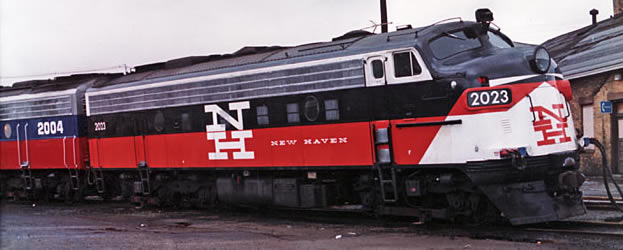
NHRHTA Collection
ConnDot Rebuilds
Since 1983, Connecticut Department of Transportation has contracted with Metro-North to operate the commuter trains on MN territory located in the state of Connecticut. At the time of the 1983 MN inception, CDOT took title to four out-of-service Conrail FL9s. These four units soon were sent to Chrome Locomotive in Silvis, Illinois, for a complete rebuild that would include Head End Power (HEP) capability for use with new on-order Bombardier push-pull coaches. All four returned to home territory in 1985, and attracted the attention of railfans worldwide as they wore a direct copy of the original New Haven scheme! Later, six more FL9s were transferred from Metro-North to CDOT. Rebuilding at Morrison-Knudsen in Boise, Idaho also included a full repaint in the original NH scheme. The last of these M-K rebuilds continued in Metro-North commuter service on former NH and New York Central routes continued well into 2009, more than fifty years after they were originally built!
